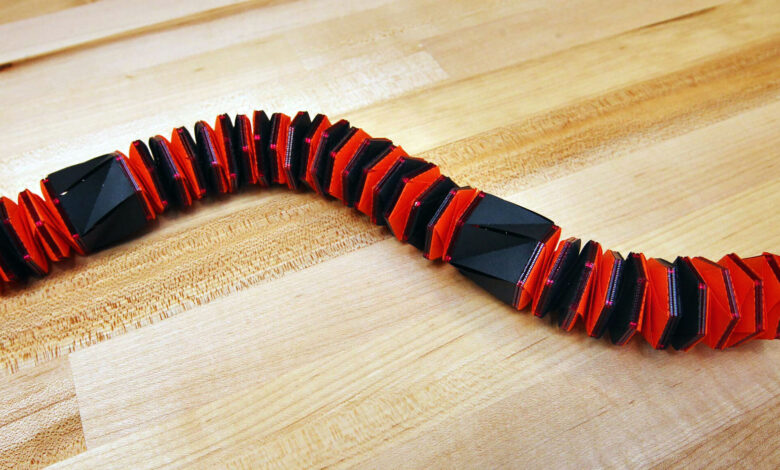New “soft robot” can crawl and move like origami folds • Earth.com

Picture a robot. You’re probably imagining something metallic, with rigid joints and whirring motors. But what if robots could be soft and squishy?
Soft robotics is a fascinating field where engineers take inspiration from nature. Instead of hard shells, these robots use flexible materials that can bend, stretch, and twist like origami, opening up possibilities for new ways robots can interact with the world.
However, controlling a floppy robot is no easy task. How do you steer something that can bend in any direction? Researchers at Princeton and North Carolina State University have a brilliant solution, inspired by the ancient art of origami.
“The concept of modular soft robots can provide insight into future soft robots that can grow, repair, and develop new functions,” the team explains.
What Is the new soft robot like?
“Caterbot”, the innovative soft robot, breaks from traditional designs. Instead of a single, rigid body, it’s constructed from a series of patterned cylinders stacked vertically.
These cylinders are the secret to its adaptability – each one possesses the ability to collapse into a flat disk and then re-expand into its full cylindrical form. The pattern that allows this unique folding and expansion is called a Kresling pattern.
The Kresling pattern allows the robot to mimic the movements of its natural inspiration, the caterpillar. By carefully controlling which segments fold, bend, or expand, the Caterbot gains the ability to twist, turn, and navigate tight corners with remarkable precision.
It can even change its shape to squeeze and wriggle its way through challenging obstacles, demonstrating an unprecedented level of flexibility in robotics.
Building steering into the origami soft robot
Steering a typical soft robot often requires tacking on extra equipment, making it bulky. This added weight and complexity can hinder the very flexibility that makes soft robots attractive. The Princeton and NC State team found an elegant way to integrate the steering directly into the robot’s structure.
They turned to specialized materials science. By combining two materials that expand and contract differently when heated, they created a system that mimics the action of biological muscle. These materials are cleverly layered along the folds of the robot’s origami-like segments.
The researchers also incorporated a network of super-thin heating elements, much like minuscule wires, within the structure. Sending carefully controlled electrical currents through these heating elements allows the team to selectively heat specific areas of the robot’s skin.
This localized heating causes the expansion and contraction materials to react, resulting in precise bending and folding that enables the robot to steer in the desired direction.
“In this work, we achieved localized, sharp folding to actuate the origami pattern. This effective actuation method can be generally applied to origami structures for soft robotics,” explains Shuang Wu, a researcher at NC State.
What can the origami soft robot do?
This shape-shifting caterpillar-bot isn’t just about wriggling through obstacles. It can move with precision – inching forward, reversing direction, and skillfully navigating even the most complex and twisted pathways. If a task requires moving an object, the Caterbot’s adaptable design allows it to grasp and transport small items.
But here’s where things get truly exciting – the robot’s modular construction sets it apart. Each segment functions as an independent building block.
These individual units can detach and seamlessly reattach into entirely new configurations, offering immense flexibility for adapting to different tasks and environments.
Future directions
The modular design of this robot opens up a world of possibilities. Picture a swarm of these tiny robots, each working in tandem. They could collaborate to access confined areas during search and rescue missions, navigating through collapsed structures or hazardous environments.
The medical field also holds tremendous potential, envision flexible medical robots able to move with precision through delicate areas of the human body, revolutionizing less invasive procedures.
“We have created a bio-inspired plug-and-play soft modular origami robot… This is a very promising technology with potential translation to robots that can grow, heal, and adapt on demand,” explains Glaucio Paulino, a Princeton professor leading the research.
This vision highlights the goal of creating robots that can expand their form, potentially repair themselves, and seamlessly adapt to the task at hand.
Although refining the Caterbot’s speed and steering precision requires more work, the core concept demonstrates the remarkable power of origami. This ancient art form, traditionally executed with simple paper, is now influencing the forefront of robotic innovation.
It’s a thrilling example of how blending old and new can spark extraordinary breakthroughs, leaving us excited to imagine what incredible feats these flexible, adaptable robots might achieve in the future.
The study is published in the journal Proceedings of the National Academy of Sciences.
—–
Like what you read? Subscribe to our newsletter for engaging articles, exclusive content, and the latest updates.
Check us out on EarthSnap, a free app brought to you by Eric Ralls and Earth.com.
—–



